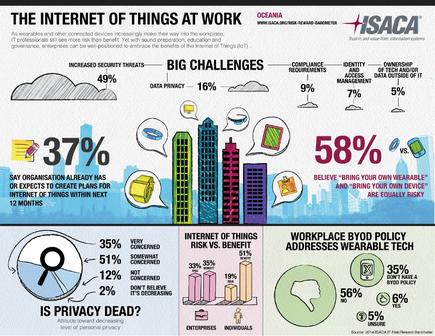
More than a third (37 per cent) of Australia and New Zealand members of ISACA surveyed for the IT Risk/Reward Barometer say their organisation has plans now or expects to create plans in the next 12 months to leverage the IoT, but the majority is not ready for wearable tech.
Just over a third - 35 per cent - believe the benefit of IoT outweighs the risk for enterprises.
More than half (56 per cent) say their BYOD policy does not address wearable tech and another 35 per cent do not even have a BYOD policy. More than half of the respondents from ANZ likewise believe having wearable technology in the workplace is risky.
“Many organisations have existing acceptable use and BYOD policies, but the ISACA survey reveals very few in our region have policies covering the risks and issues with wearables in the workplace,” notes Garry Barnes, ISACA International vice president.
“The Internet of Things is here, and we are likely to see a surge in wearable devices in the workplace,” he adds. “These devices can deliver great value, but they can also bring great risk. Companies should take an ‘embrace and educate’ approach.”
This means businesses must firstly acknowledging that wearable technology is now part of people’s daily lives, such as with fitness and health trackers, and secondly considering the specific risks that these may pose, says Barnes.
Read more: CIOs need to proactively supply the business with ‘platforms of innovation’

These devices can deliver great value, but they can also bring great risk. Companies should take an ‘embrace and educate’ approach.
“These risks might include unintended surveillance, illicit recording, and use or misuse of private health information. These risks could also vary among job roles within a business, for example with executive and security staff.”
Read more: Massachusets Institute of Technology professors discuss the ‘impossible’ role of the CIO
ISACA’s IT Risk/Reward Barometer looks at attitudes and behaviours related to the risks and rewards of key technology trends, including the IoT and BYOD. It has two components: a survey of 1646 ISACA members who are IT and business professionals around the world, and a survey of more than 4000 consumers in four countries.

Read more: The evolving CIO agenda
Gartner, meanwhile, forecasts that 4.9 billion connected things will be in use in 2015, up 30 per cent from this year, and will reach 25 billion by 2020.
From an industry perspective, manufacturing, utilities and transportation will be the top three verticals using IoT in 2015 – all together they will have 736 million connected things in use, reports Gartner.
By 2020, the ranking will shift with utilities taking the number one spot, manufacturing will be second and government will be third, totaling 1.7 billion IoT units installed.
Government will take the number three spot as it invests in smart street and area lighting for energy saving reasons, says Jim Tully, vice president and distinguished analyst at Gartner. “Utilities will move to the top position because of investment in smart meters.”
Read more: AWS re:Invent: Transform the enterprise through the cloud
Connected things, such as automated teller machines and airline check-in machines, have previously existed. But, new and novel devices, and many ordinary objects, are also being reinvented with digital sensing, computing and communications capabilities.
CIOs must understand that the most disruptive impact and competitive threats — and, equally, the greatest competitive opportunities — arise not from simply digitalising a product or service, but from creating a new business model and value proposition.
Gartner says this functionality provides both new and previously passive objects with a "digital voice", and the ability to create and deliver an information stream reflecting their status and that of their surrounding environment.
Read more: The Internet of Things outpaces other technologies: IDC
Such developments radically change the value proposition, creating new services and usage scenarios and driving new business models.
It is likely that within the next few years, some level of built-in intelligence and connectivity will be regarded as standard, and this will rapidly filter down to mainstream products and services, says Gartner.
“However, CIOs must understand that the most disruptive impact and competitive threats — and, equally, the greatest competitive opportunities — arise not from simply digitalising a product or service, but from creating a new business model and value proposition,” says Steve Prentice, vice president and Gartner Fellow.
“Organisations must straddle the tension of all the information available from smart things by balancing their desire to collect and analyse it with the risk of its loss or misuse,” says Prentice.
The IoT highlights the tight linkages between information security, information technology security, operational technology security and physical security like never before. Executives now face a decision regarding the future of security in their enterprise and who governs, manages and operates it.
“The number of connected intelligent devices will continue to grow exponentially, giving ’smart things’ the ability to sense, interpret, communicate and negotiate, and effectively have a digital ‘voice’," says Prentice. “CIOs must look for opportunities to create new services, usage scenarios and business models based on this growth.”
Send news tips and comments to divina_paredes@idg.co.nz
Follow Divina Paredes on Twitter: @divinap
Follow CIO New Zealand on Twitter:@cio_nz
Sign up for CIO newsletters for regular updates on CIO news, views and events.
Join the CIO New Zealand group on LinkedIn. The group is open to CIOs, IT Directors, COOs, CTOs and senior IT managers.
